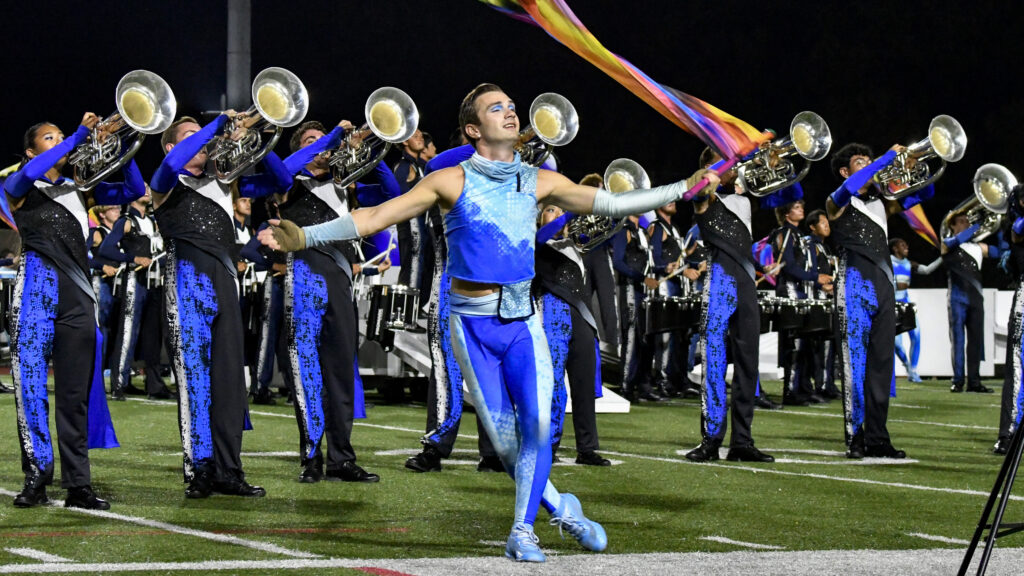When Steve needed someone to write his latest contribution to preserving our heritage, he turned to Nicholas Waerzeggers, who had served as an intern with Steve at Drum Corps World for two summers. Nicholas does not have a drum corps background, and that has served him well in separating the facts from the legends that make up the voluminous text of this 212-page tome.
Don’t let the size of the book scare you; this is (in my opinion) the most captivating, engrossing, spellbinding collection of stories I have ever read about our activity. Tracing the history of DCI from its inception through its first 10 years, the book is a continual regaling of the remarkable circumstances that swirled together to forever change the face of drum corps, garnered from Drum Corps World and DCI archives and interviews with almost 250 people who have contributed to DCI’s evolution.
Prior to individual chapters on each of the 10 years, “The Pre-DCI Backdrop” explores the intertwining histories of the activity’s top corps, histories that to most people might not seem to have any connection to the eventual formation of DCI. I wasn’t aware that the appearance of the newly-named Garfield Cadets at the 1958 American Legion National Championship would not have been possible without the lending of equipment by the Chicago Cavaliers, identified as an early sign that corps would need to pool their resources to survive. Furthermore, this act brought the two corps directors together to eventually unite corps from the East and Midwest under the banner of DCI. The care with which Waerzeggers traces this evolution leads the reader down what could have been a complicated route with the ease of following a GPS through the streets of an unfamiliar city.
“Life Under the Veterans Organizations” exposes us to the how and why regarding the stranglehold held on drum corps by the VFW and American Legion. I had no idea that the kingpin of the VFW National Championship only attended one show each year, which served to color his perspective of what drum corps was and what it should be. Why the rules between the two organizations developed the way they did helped generate a sense of ambition in corps directors and instructors to break away from what was viewed as an increasing tyranny. How drum corps ended up embracing the growing marching band movement (without always realizing it) and allowed a new breed of judges to become involved (who were to forever change how instructors would think about creating and teaching their shows) adds additional ingredients to the stew now brewing that would soon bubble over the rim of the drum corps melting pot.
“High Noon in a Wisconsin Bathroom” recounts the results of the short verbal exchange between Chicago Cavaliers’ Don Warren and Troopers’ Jim Jones that swelled like a compressed dry sponge dropped exposed to water for the first time. The subject of overage members comes up and is paired with the reason some new corps started up as coed units, while other existing all-male corps were forced to turn coed; the effects of the Vietnam War on membership. Meanwhile, suspicions and distrust across the various regions of drum corps began eroding almost all mutual trust that had been generated through the years, albeit a small amount of trust to begin with. It’s a wonder, then, that the corps themselves seized the reins and set on the road to unite as one entity, after first passing through the year of the Midwest Combine and the eastern seaboard United Organization of Junior Corps, and how a single judge, Don Angelica, used his influence and powers of persuasion to turn judging upside down and direct it toward the eventual rewarding of accomplishment rather than the less educationally-supportive teardown methods of the tic system. Although this took well more than a decade to accomplish, it was all set into motion back before the formation of DCI.
One of the most interesting stories in “Where Does That Leave Us” follows the path taken by those who created the shows in response to the rules of the day. While the autocratic VFW contest director Tony Schlecta drew attention to corps spending themselves into possible oblivion with the latest bugles, he forbade the use of inexpensive percussion equipment such as cowbells and woodblocks. (Remarkably, a couple chapters later, we learn how Schlecta predicted the coming of the pit.) And north of the border, Canadian drum corps were trying to figure out the direction of the activity, feeling increasingly alone as if they were floating on an ice shelf in the Arctic Ocean. The increased level at which small corps were becoming extinct foreshadowed a problem that has been one of the unfortunate byproducts of increased travel and other expenses through the coming four decades.
After dozens of pages of evolution that had me practically holding my breath as I turned each page, the book gets into a year-by-year exploration of the first 10 years of DCI’s existence. “1972: Destination Whitewater.” Despite having been a friend and judge trainee of legendary music arranger Ray Baumgardt, I never knew that his involvement that first DCI season was with a full one-third of the top 15 corps that showed up in Whitewater for the first DCI World Championship. If I was to account for all the similar things in this book of which I wasn’t aware, this review might be as long as the book itself. The intrigue of the various corps moving around the continent, trying to figure out this new animal named DCI, demonstrates that hardly anyone had an idea about what to expect come Whitewater.
“1973: A Honeymoon, of Sorts” explores how and why Donald Pesceone became the first Executive Director of DCI and how he ran the organization out of the basement of his home. The goings on at the first DCI Rules Congress started the direction toward the increased importance of subjective analysis on the judges’ sheets. Of particular interest is the printing of DCI’s 1971-1972 balance sheet, showing a total budget that didn’t reach $50,000 and a year-end balance of $11.48.
In “1974: Growing Pains and the Era of Public Relations,” Santa Clara Vanguard director Gail Royer kicked in several thousand dollars and lent Blue Rock the SCV bus fleet so the corps could finish its trip to California after devastating breakdowns in Utah. The Troopers spent far more in a five-year period to maintain their buses than it cost to buy them. The stresses of touring knew no distinction between those new and old to the concept. At the Rules Congress, it was decided that for 1974, various mallet instruments (to be worn and not grounded), horn mutes and a second valve would be allowed on the field. A debate about what was General Effect commenced, one that is still going on today. Overall, the lasting impact of that meeting was set into motion allowing instructors and designers increased responsibility on deciding what drum corps should become.
With such a wealth of information regarding DCI’s first three seasons, (of which I barely scratched the surface above), I wish there was space available to discuss each of the remaining years of DCI’s first decade. I realized I wasn’t as tuned in to DCI’s formative years as I had thought. For example, I was blown away to read that in 1976, it was Santa Clara Vanguard director Gail Royer (a band director), who made the most impassioned argument about why bugles should stay with just one valve so as not to not look like marching band instruments…in order to maintain a distinction between the two activities.
Due to the remarkable number of insights presented in this book, I believe it will easily be something that drum corps fans will pick up and read multiple times. It should be required reading for current corps members as their buses crisscross America. “DCI The First Decade” is currently available for $20 from Drum Corps International’s online store or by calling 317.275.1212. It is also available as a special bundle with “DCI The First 35 Years in Photos” for $35. Order today at store.DCI.org

Michael Boo was a member of the Cavaliers from 1975-1977. He has written about the drum corps activity for more than a quarter century and serves as a staff writer for various Drum Corps International print and Web projects. Boo has written for numerous other publications and has published an honors-winning book on the history of figure skating. As an accomplished composer, Boo holds a bachelor's degree in music education and a master's degree in music theory and composition. He resides in Chesterton, Ind.





